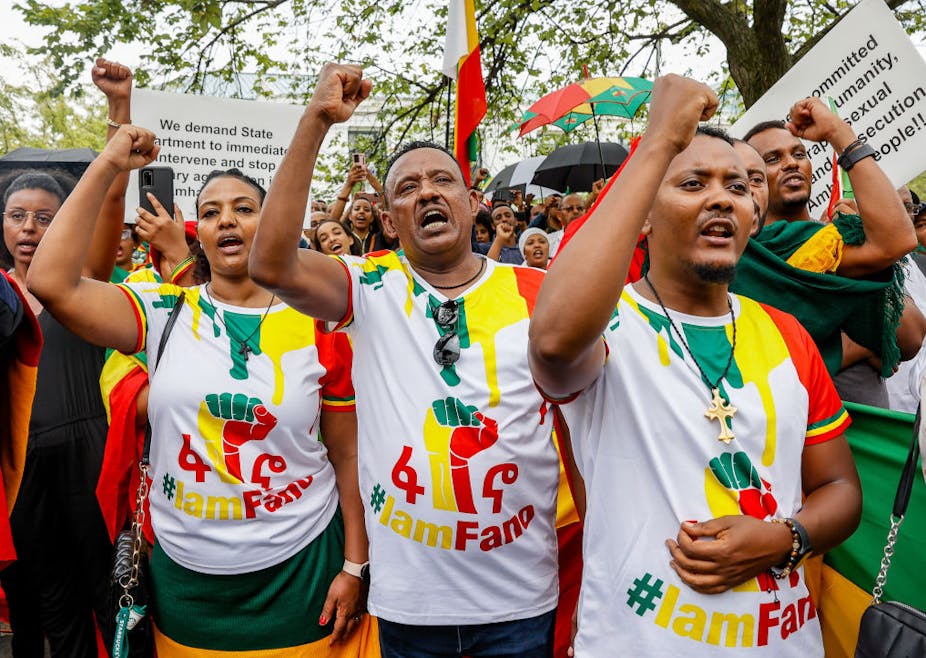
Ethiopia’s civil war: what’s behind the Amhara rebellion?
Published: April 2, 2025
Amanuel Tesfaye, University of Helsinki, Yared Debebe, University of Gondar
https://theconversation.com/ethiopias-c ... ion-252425

Ethiopians in the US protest against attacks by the Ethiopian government in the Amhara region. J. Countess/Getty Images
Ethiopia is in the grip of a civil war https://www.crisisgroup.org/africa/horn ... war-amhara between federal government forces and the Fano, a loose alliance of ethnic-based militia in the Amhara region.
This conflict in Ethiopia’s north erupted less than a year after the devastating Tigray war, https://theconversation.com/ethiopia-ti ... ict-193636 which ended in 2022.
The Amhara https://www.britannica.com/topic/Amhara are one of Ethiopia’s largest ethnic groups and played a leading role in the making of the Ethiopian state. Amharic https://www.polilingua.com/blog/post/of ... hiopia.htm serves as the country’s working language.
The region shares a border with Tigray. During the Tigray war, which began in 2020, various Fano groups allied with the federal government. https://riftvalley.net/wp-content/uploa ... pdf#page=2
A peace deal in 2022 to stop the war sidelined the Amhara militia groups, which strained relations with the government.
The Amhara conflict began as minor sporadic clashes with government forces in April 2023. This rapidly escalated into a full-scale insurgency by August when Fano forces launched a full blown attack in an effort to control the region’s major cities.
The violence since has displaced more than 100,000 people and left 4.7 million children out of school. https://theconversation.com/9-million-e ... -do-247697
The death toll from the conflict is piling up. https://www.hrw.org/news/2024/04/04/eth ... ara-region
In March 2025, the government claimed to have killed more than 300 Fano fighters. https://www.aljazeera.com/news/2025/3/2 ... d-fighting
We are researchers studying ethnic nationalism, social movements and insurgency in Ethiopia, with a focus on Amhara. Based on our studies into the Fano https://orcid.org/0000-0003-0529-9382?lang=en and ongoing research https://www.cmi.no/publications/8570-yo ... t-pathways on Ethiopia’s political reforms process, we see three factors behind the escalating armed struggle in Amhara:
• a mismanaged political transition from 2018 to 2020
• fallout from the 2020-2022 Tigray war
• a hollow pursuit of peace.
Mismanaged transition
Between 1991 and 2018, Ethiopia was governed by the Ethiopian People’s Revolutionary Democratic Front. This was a powerful coalition of four ethno-national parties representing Tigray, Amhara, Oromo, and Southern nations, nationalities and peoples.
Faced with a political crisis and growing unrest in 2014 https://2009-2017.state.gov/documents/o ... 236570.pdf following opposition clampdowns and arbitrary arrests, the coalition needed a change. Two members – the Oromo People’s Democratic Organisation and the Amhara National Democratic Movement – joined forces to oust the Tigray People’s Liberation Front from its dominant position. They did this by leveraging youth-led protests, https://www.thereporterethiopia.com/9932/ which played out between 2015 and 2018.
Following the resignation of prime minister Hailemariam Desalegn in 2018, the two parties orchestrated Abiy Ahmed’s ascent to power. https://addisstandard.com/breaking-dr-a ... t-decided/
For a moment, the relationship between the Oromo and Amhara wings of the coalition looked like one of equals. This didn’t last. In December 2019, https://www.ena.et/web/eng/w/en_34154 Abiy merged the coalition into a single party, the Prosperity Party.
The Oromo wing positioned itself as the core of the Prosperity Party. It monopolised key political positions and economic opportunities. This included asserting control over the capital, Addis Ababa.
Amhara’s outspoken leaders who criticised this dominance faced removal, arrest https://www.bbc.com/news/world-africa-61591159 or exile. https://borkena.com/2024/02/05/ethiopia ... al-asylum/
The region’s president, Ambachew Mekonnen, was assassinated https://www.aljazeera.com/news/2019/6/2 ... up-attempt in June 2019.
Harassment, https://addisstandard.com/news-analysis ... dis-abeba/ kidnappings https://adf-magazine.com/2024/10/kidnap ... toke-fear/ for ransom and arrests were daily experiences for Amhara region residents trying to enter Addis Ababa. https://borkena.com/2022/08/14/traveler ... dis-ababa/
Members of the Amhara community also faced ethnic-based violence https://ehrc.org/violence-human-rights- ... ssination/ in various parts of the country.
These incidents provoked anti-government protests https://www.amharaamerica.org/post/aaa- ... -violence/ throughout Amhara.
Fallout from the Tigray war
A peace agreement https://igad.int/wp-content/uploads/202 ... t-here.pdf signed in 2022 in South Africa ended a brutal two-year war in Tigray and neighbouring regions. However, it deepened the sense of marginalisation in Amhara.
While the agreement silenced the guns in Tigray, it sidelined Amhara constituencies by denying them representation in the talks despite the region being affected by the war. The agreement’s ambiguity regarding the fate of territories disputed between Amhara and Tigray, https://kujenga-amani.ssrc.org/2024/03/ ... ted-areas/ such as Welkait, further fuelled distrust.
The last nail in the coffin came in April 2023. The government decided to dismantle https://www.reuters.com/world/africa/et ... 023-04-06/ regional special forces. This was ostensibly aimed at consolidating the country’s fighting forces.
However, with unresolved territorial disputes and Oromo nationalist ambitions at the centre, disarming the Amhara Special Forces was interpreted as a move to weaken Amhara defences. Additionally, the more than 200,000-strong Tigray Defence Forces https://worldpeacefoundation.org/wp-con ... 230829.pdf were left intact. This contributed to a sense of vulnerability in neighbouring Amhara.
Public protests https://www.bbc.com/news/world-africa-65194146 led to clashes with government forces. These protests morphed into an insurgency https://www.aljazeera.com/news/2023/8/2 ... s-reported by the Fano in the following months.
The insurgency has expanded its reach and has public support https://riftvalley.net/publication/unde ... ra-region/ across the region and in the diaspora.
The Fano insurgency is taking place in a territory three times the size of Tigray, stretching the federal army.
Various Fano factions cite objectives that range from the protection of Amhara interests https://www.amharaamerica.org/post/excl ... nt-affairs to constitutional change and overthrowing the federal government. https://www.thenewhumanitarian.org/news ... -rebellion
However, the insurgency is still in its infancy. It lacks unified leadership, a cohesive structure or a chain of command. Factional divisions and competition persist, and there are no clear objectives.
Hollow pursuit of peace
The government seems determined to crush the Fano insurgency by force. https://www.aljazeera.com/news/2025/3/2 ... d-fighting
A state of emergency was declared in August 2023 https://www.theguardian.com/global-deve ... g-violence for six months. It was later extended.
While the state of emergency in Amhara officially ended in June 2024, some restrictions remain in place. This includes de facto curfews https://www.amnesty.org/en/latest/news/ ... ra-region/ in major cities, including the capital Bahir Dar.
The counterinsurgency relies on heavy Ethiopian National Defence Forces deployments and drone strikes. https://www.dw.com/en/ethiopia-civilian ... a-70946525
On the other hand, the government has indicated its openness to peace talks. However, it has avoided meaningful confidence-building measures, such as releasing Amhara political prisoners. A Peace Council https://www.bbc.com/amharic/articles/c4ge9ynvjpdo established to mediate between the Fano and the government has proven ineffective. Its spokesperson https://www.ethiopianreporter.com/137924/ has noted federal reluctance to negotiate.
The government’s peace efforts have centred on repeated calls for insurgents to surrender. There are reports https://www.thereporterethiopia.com/41359/ that the government wants to talk to different Fano factions separately in the hope of fragmenting the insurgency further. Secret talks https://wazemaradio.com/%e1%8b%a8%e1%8d ... %e1%89%b5/ with one faction of the Fano are an indication of this strategy.
The path forward
The government’s violent counterinsurgency and occasional peace overtures are unlikely to succeed. The Prosperity Party is not popular https://theconversation.com/ethiopias-a ... war-211754 in Amhara. A meaningful peace process – rather than calls for surrender or attempts to co-opt factions – is essential. This should start with measures like releasing arbitrarily detained Amhara activists, journalists, academics and politicians.
The federal government also needs to be part of a multi-stakeholder negotiation involving all Fano factions, civil society, community leaders, and domestic and diaspora-based opposition groups. Unbiased mediation from regional and international players may also be useful. Past attempts at piecemeal talks with factions of armed groups – be it in Tigray or Oromia – have prolonged insurgencies or fostered new ones. Only a comprehensive, all-inclusive dialogue can address the crisis.
Such a process needs to address deep-seated structural challenges. This includes ensuring the protection of Amhara minorities living in other regions, and the region’s representation within local, regional and federal government structures. Territorial disputes need to be addressed through a process rooted in historical context, constitutional principles and the consent of the people concerned.
Ultimately, enduring peace requires ending the cycle of ethnic dominance in Ethiopia’s federal governance https://theconversation.com/what-is-fed ... ect-217217 arrangement.



